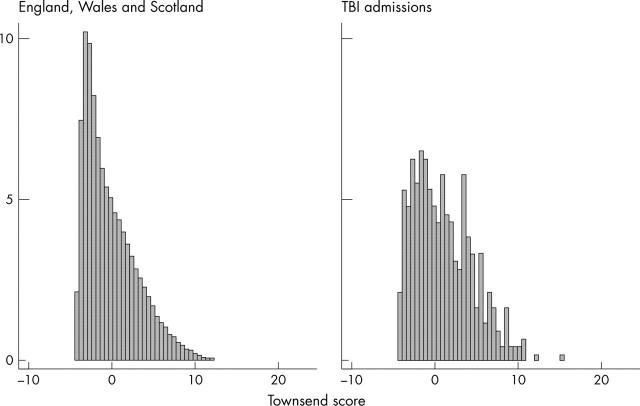Abstract
Aims: To describe the epidemiology of children with traumatic brain injury (TBI) admitted to paediatric intensive care units (PICUs) in the UK.
Methods: Prospective collection of clinical and demographic information from paediatric and adult intensive care units in the UK and Eire between February 2001 and August 2003.
Results: The UK prevalence rate for children (0–14 years) admitted to intensive care with TBI between February 2001 and August 2003 was 5.6 per 100 000 population per year (95% Poisson exact confidence intervals 5.17 to 6.05). Children admitted to PICUs with TBI were more deprived than the population as a whole (mean Townsend score for TBI admissions 1.19 v 0). The commonest mechanism of injury was a pedestrian accident (36%), most often occurring in children over 10. There was a significant summer peak in admissions in children under 10 years. Time of injury peaked in the late afternoon and early evening, a pattern that remained constant across the days of the week. Injuries involving motor vehicles have the highest mortality rates (23% of vehicle occupants, 12% of pedestrians) compared with cyclists (8%) and falls (3%). In two thirds of admissions (65%) TBI was an isolated injury.
Conclusions: TBI in children requiring intensive care is more common in those from poorer backgrounds who have been involved in accidents as pedestrians. The summer peak in injury occurrence for 0–10 year olds and late afternoon timing give clear targets for community based injury prevention.
Full Text
The Full Text of this article is available as a PDF (87.3 KB).
Figure 1.
Comparison of Townsend score between general population of England, Wales, and Scotland and children admitted with TBI to PICUs (2001 Census). Based on 419 admissions for whom a valid home address postcode was available.
Figure 2.
Seasonality of admissions by age group 2001–03. Data based on admissions between 1 February 2001 and 31 August 2003 and excluding 20 children for whom an admission month was not available.
Figure 3.
Time of injury (supplied for 362 admissions).
Selected References
These references are in PubMed. This may not be the complete list of references from this article.
- Andersson E. H., Björklund R., Emanuelson I., Stålhammar D. Epidemiology of traumatic brain injury: a population based study in western Sweden. Acta Neurol Scand. 2003 Apr;107(4):256–259. doi: 10.1034/j.1600-0404.2003.00112.x. [DOI] [PubMed] [Google Scholar]
- Baldo Vincenzo, Marcolongo Adriano, Floreani Annarosa, Majori Silvia, Cristofolettil Marco, Dal Zotto Alessandra, Vazzoler Gabriele, Trivello Renzo. Epidemiological aspect of traumatic brain injury in Northeast Italy. Eur J Epidemiol. 2003;18(11):1059–1063. doi: 10.1023/a:1026192020963. [DOI] [PubMed] [Google Scholar]
- Bruns John, Jr, Hauser W. Allen. The epidemiology of traumatic brain injury: a review. Epilepsia. 2003;44 (Suppl 10):2–10. doi: 10.1046/j.1528-1157.44.s10.3.x. [DOI] [PubMed] [Google Scholar]
- Bunn F., Collier T., Frost C., Ker K., Roberts I., Wentz R. Traffic calming for the prevention of road traffic injuries: systematic review and meta-analysis. Inj Prev. 2003 Sep;9(3):200–204. doi: 10.1136/ip.9.3.200. [DOI] [PMC free article] [PubMed] [Google Scholar]
- Craft A. W., Shaw D. A., Cartlidge N. E. Head injuries in children. Br Med J. 1972 Oct 28;4(5834):200–203. doi: 10.1136/bmj.4.5834.200. [DOI] [PMC free article] [PubMed] [Google Scholar]
- EDWARDS J. H. The recognition and estimation of cyclic trends. Ann Hum Genet. 1961 May;25:83–87. doi: 10.1111/j.1469-1809.1961.tb01501.x. [DOI] [PubMed] [Google Scholar]
- Hawley Carol A., Ward Anthony B., Long Julie, Owen David W., Magnay Andrew R. Prevalence of traumatic brain injury amongst children admitted to hospital in one health district: a population-based study. Injury. 2003 May;34(4):256–260. doi: 10.1016/s0020-1383(02)00193-6. [DOI] [PubMed] [Google Scholar]
- Hawley Carol A., Ward Anthony B., Magnay Andrew R., Long Julie. Parental stress and burden following traumatic brain injury amongst children and adolescents. Brain Inj. 2003 Jan;17(1):1–23. doi: 10.1080/0269905021000010096. [DOI] [PubMed] [Google Scholar]
- Hippisley-Cox Julia, Groom Lindsay, Kendrick Denise, Coupland Carol, Webber Elizabeth, Savelyich Boki. Cross sectional survey of socioeconomic variations in severity and mechanism of childhood injuries in Trent 1992-7. BMJ. 2002 May 11;324(7346):1132–1132. doi: 10.1136/bmj.324.7346.1132. [DOI] [PMC free article] [PubMed] [Google Scholar]
- Jennett B. Epidemiology of head injury. J Neurol Neurosurg Psychiatry. 1996 Apr;60(4):362–369. doi: 10.1136/jnnp.60.4.362. [DOI] [PMC free article] [PubMed] [Google Scholar]
- Kendrick D., Royal S., Lids for Kids project team Cycle helmet ownership and use; a cluster randomised controlled trial in primary school children in deprived areas. Arch Dis Child. 2004 Apr;89(4):330–335. doi: 10.1136/adc.2003.032052. [DOI] [PMC free article] [PubMed] [Google Scholar]
- Kraus J. F., Fife D., Cox P., Ramstein K., Conroy C. Incidence, severity, and external causes of pediatric brain injury. Am J Dis Child. 1986 Jul;140(7):687–693. doi: 10.1001/archpedi.1986.02140210085032. [DOI] [PubMed] [Google Scholar]
- Liabo Kristin, Lucas Patricia, Roberts Helen. Can traffic calming measures achieve the Children's Fund objective of reducing inequalities in child health? Arch Dis Child. 2003 Mar;88(3):235–236. doi: 10.1136/adc.88.3.235. [DOI] [PMC free article] [PubMed] [Google Scholar]
- Phillimore P., Beattie A., Townsend P. Widening inequality of health in northern England, 1981-91. BMJ. 1994 Apr 30;308(6937):1125–1128. doi: 10.1136/bmj.308.6937.1125. [DOI] [PMC free article] [PubMed] [Google Scholar]
- Segui-Gomez Maria, MacKenzie Ellen J. Measuring the public health impact of injuries. Epidemiol Rev. 2003;25:3–19. doi: 10.1093/epirev/mxg007. [DOI] [PubMed] [Google Scholar]
- Sharples P. M., Storey A., Aynsley-Green A., Eyre J. A. Causes of fatal childhood accidents involving head injury in northern region, 1979-86. BMJ. 1990 Nov 24;301(6762):1193–1197. doi: 10.1136/bmj.301.6762.1193. [DOI] [PMC free article] [PubMed] [Google Scholar]
- Stark Andrew D., Bennet George C., Stone David H., Chishti Parveen. Association between childhood fractures and poverty: population based study. BMJ. 2002 Feb 23;324(7335):457–457. doi: 10.1136/bmj.324.7335.457. [DOI] [PMC free article] [PubMed] [Google Scholar]
- Williamson L. M., Morrison A., Stone D. H. Trends in head injury mortality among 0-14 year olds in Scotland (1986-95). J Epidemiol Community Health. 2002 Apr;56(4):285–288. doi: 10.1136/jech.56.4.285. [DOI] [PMC free article] [PubMed] [Google Scholar]
- Yeates Keith Owen, Swift Erika, Taylor H. Gerry, Wade Shari L., Drotar Dennis, Stancin Terry, Minich Nori. Short- and long-term social outcomes following pediatric traumatic brain injury. J Int Neuropsychol Soc. 2004 May;10(3):412–426. doi: 10.1017/S1355617704103093. [DOI] [PubMed] [Google Scholar]





